Sai Rajeswar
Grammar Search for Multi-Agent Systems
Dec 16, 2025Abstract:Automatic search for Multi-Agent Systems has recently emerged as a key focus in agentic AI research. Several prior approaches have relied on LLM-based free-form search over the code space. In this work, we propose a more structured framework that explores the same space through a fixed set of simple, composable components. We show that, despite lacking the generative flexibility of LLMs during the candidate generation stage, our method outperforms prior approaches on four out of five benchmarks across two domains: mathematics and question answering. Furthermore, our method offers additional advantages, including a more cost-efficient search process and the generation of modular, interpretable multi-agent systems with simpler logic.
Grounding Computer Use Agents on Human Demonstrations
Nov 10, 2025



Abstract:Building reliable computer-use agents requires grounding: accurately connecting natural language instructions to the correct on-screen elements. While large datasets exist for web and mobile interactions, high-quality resources for desktop environments are limited. To address this gap, we introduce GroundCUA, a large-scale desktop grounding dataset built from expert human demonstrations. It covers 87 applications across 12 categories and includes 56K screenshots, with every on-screen element carefully annotated for a total of over 3.56M human-verified annotations. From these demonstrations, we generate diverse instructions that capture a wide range of real-world tasks, providing high-quality data for model training. Using GroundCUA, we develop the GroundNext family of models that map instructions to their target UI elements. At both 3B and 7B scales, GroundNext achieves state-of-the-art results across five benchmarks using supervised fine-tuning, while requiring less than one-tenth the training data of prior work. Reinforcement learning post-training further improves performance, and when evaluated in an agentic setting on the OSWorld benchmark using o3 as planner, GroundNext attains comparable or superior results to models trained with substantially more data,. These results demonstrate the critical role of high-quality, expert-driven datasets in advancing general-purpose computer-use agents.
AU-Harness: An Open-Source Toolkit for Holistic Evaluation of Audio LLMs
Sep 11, 2025Abstract:Large Audio Language Models (LALMs) are rapidly advancing, but evaluating them remains challenging due to inefficient toolkits that limit fair comparison and systematic assessment. Current frameworks suffer from three critical issues: slow processing that bottlenecks large-scale studies, inconsistent prompting that hurts reproducibility, and narrow task coverage that misses important audio reasoning capabilities. We introduce AU-Harness, an efficient and comprehensive evaluation framework for LALMs. Our system achieves a speedup of up to 127% over existing toolkits through optimized batch processing and parallel execution, enabling large-scale evaluations previously impractical. We provide standardized prompting protocols and flexible configurations for fair model comparison across diverse scenarios. Additionally, we introduce two new evaluation categories: LLM-Adaptive Diarization for temporal audio understanding and Spoken Language Reasoning for complex audio-based cognitive tasks. Through evaluation across 380+ tasks, we reveal significant gaps in current LALMs, particularly in temporal understanding and complex spoken language reasoning tasks. Our findings also highlight a lack of standardization in instruction modality existent across audio benchmarks, which can lead up performance differences up to 9.5 absolute points on the challenging complex instruction following downstream tasks. AU-Harness provides both practical evaluation tools and insights into model limitations, advancing systematic LALM development.
LALM-Eval: An Open-Source Toolkit for Holistic Evaluation of Large Audio Language Models
Sep 09, 2025Abstract:Large Audio Language Models (LALMs) are rapidly advancing, but evaluating them remains challenging due to inefficient toolkits that limit fair comparison and systematic assessment. Current frameworks suffer from three critical issues: slow processing that bottlenecks large-scale studies, inconsistent prompting that hurts reproducibility, and narrow task coverage that misses important audio reasoning capabilities. We introduce LALM-Eval, an efficient and comprehensive evaluation framework for LALMs. Our system achieves a speedup of up to 127% over existing toolkits through optimized batch processing and parallel execution, enabling large-scale evaluations previously impractical. We provide standardized prompting protocols and flexible configurations for fair model comparison across diverse scenarios. Additionally, we introduce two new evaluation categories: LLM-Adaptive Diarization for temporal audio understanding and Spoken Language Reasoning for complex audio-based cognitive tasks. Through evaluation across 380+ tasks, we reveal significant gaps in current LALMs, particularly in temporal understanding and complex spoken language reasoning tasks. Our findings also highlight a lack of standardization in instruction modality existent across audio benchmarks, which can lead up performance differences up to 9.5 absolute points on the challenging complex instruction following downstream tasks. LALM-Eval provides both practical evaluation tools and insights into model limitations, advancing systematic LALM development.
Rendering-Aware Reinforcement Learning for Vector Graphics Generation
May 27, 2025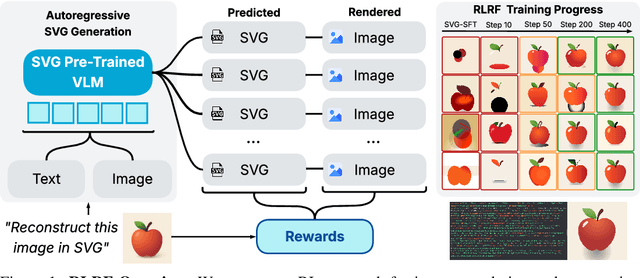
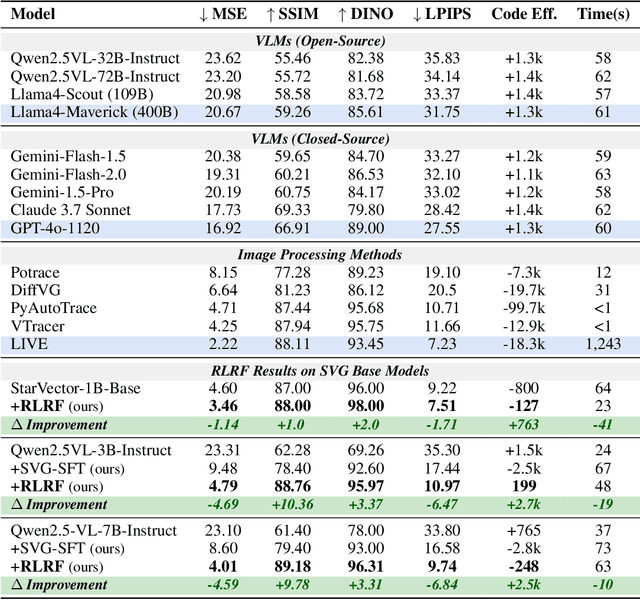

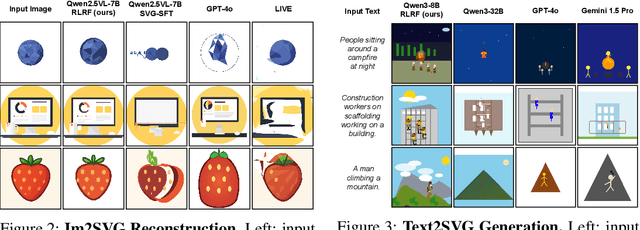
Abstract:Scalable Vector Graphics (SVG) offer a powerful format for representing visual designs as interpretable code. Recent advances in vision-language models (VLMs) have enabled high-quality SVG generation by framing the problem as a code generation task and leveraging large-scale pretraining. VLMs are particularly suitable for this task as they capture both global semantics and fine-grained visual patterns, while transferring knowledge across vision, natural language, and code domains. However, existing VLM approaches often struggle to produce faithful and efficient SVGs because they never observe the rendered images during training. Although differentiable rendering for autoregressive SVG code generation remains unavailable, rendered outputs can still be compared to original inputs, enabling evaluative feedback suitable for reinforcement learning (RL). We introduce RLRF(Reinforcement Learning from Rendering Feedback), an RL method that enhances SVG generation in autoregressive VLMs by leveraging feedback from rendered SVG outputs. Given an input image, the model generates SVG roll-outs that are rendered and compared to the original image to compute a reward. This visual fidelity feedback guides the model toward producing more accurate, efficient, and semantically coherent SVGs. RLRF significantly outperforms supervised fine-tuning, addressing common failure modes and enabling precise, high-quality SVG generation with strong structural understanding and generalization.
Augmenting LLM Reasoning with Dynamic Notes Writing for Complex QA
May 22, 2025
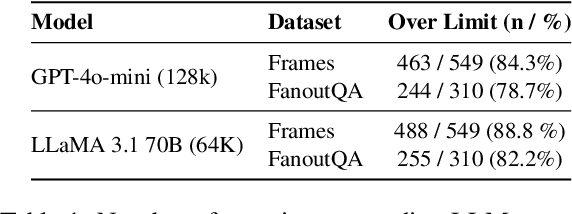
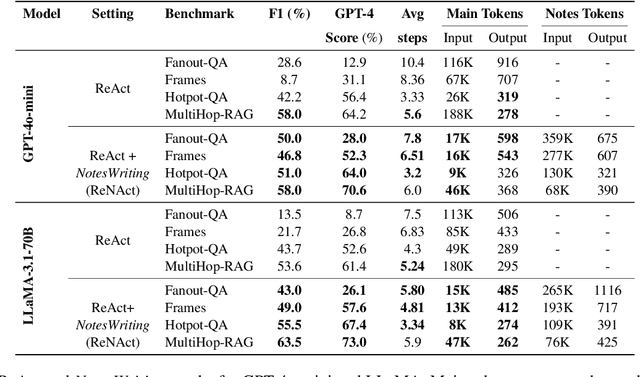
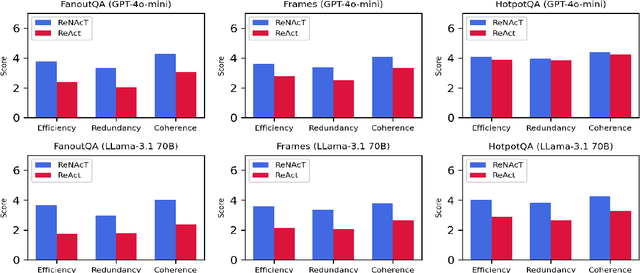
Abstract:Iterative RAG for multi-hop question answering faces challenges with lengthy contexts and the buildup of irrelevant information. This hinders a model's capacity to process and reason over retrieved content and limits performance. While recent methods focus on compressing retrieved information, they are either restricted to single-round RAG, require finetuning or lack scalability in iterative RAG. To address these challenges, we propose Notes Writing, a method that generates concise and relevant notes from retrieved documents at each step, thereby reducing noise and retaining only essential information. This indirectly increases the effective context length of Large Language Models (LLMs), enabling them to reason and plan more effectively while processing larger volumes of input text. Notes Writing is framework agnostic and can be integrated with different iterative RAG methods. We demonstrate its effectiveness with three iterative RAG methods, across two models and four evaluation datasets. Notes writing yields an average improvement of 15.6 percentage points overall, with minimal increase in output tokens.
StarFlow: Generating Structured Workflow Outputs From Sketch Images
Mar 27, 2025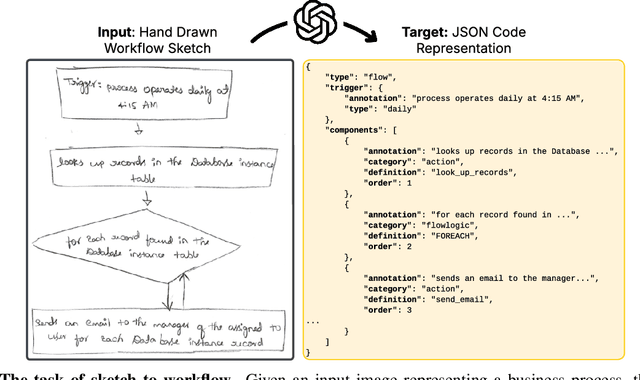


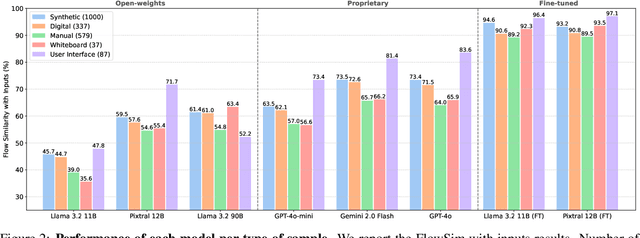
Abstract:Workflows are a fundamental component of automation in enterprise platforms, enabling the orchestration of tasks, data processing, and system integrations. Despite being widely used, building workflows can be complex, often requiring manual configuration through low-code platforms or visual programming tools. To simplify this process, we explore the use of generative foundation models, particularly vision-language models (VLMs), to automatically generate structured workflows from visual inputs. Translating hand-drawn sketches or computer-generated diagrams into executable workflows is challenging due to the ambiguity of free-form drawings, variations in diagram styles, and the difficulty of inferring execution logic from visual elements. To address this, we introduce StarFlow, a framework for generating structured workflow outputs from sketches using vision-language models. We curate a diverse dataset of workflow diagrams -- including synthetic, manually annotated, and real-world samples -- to enable robust training and evaluation. We finetune and benchmark multiple vision-language models, conducting a series of ablation studies to analyze the strengths and limitations of our approach. Our results show that finetuning significantly enhances structured workflow generation, outperforming large vision-language models on this task.
UI-Vision: A Desktop-centric GUI Benchmark for Visual Perception and Interaction
Mar 19, 2025Abstract:Autonomous agents that navigate Graphical User Interfaces (GUIs) to automate tasks like document editing and file management can greatly enhance computer workflows. While existing research focuses on online settings, desktop environments, critical for many professional and everyday tasks, remain underexplored due to data collection challenges and licensing issues. We introduce UI-Vision, the first comprehensive, license-permissive benchmark for offline, fine-grained evaluation of computer use agents in real-world desktop environments. Unlike online benchmarks, UI-Vision provides: (i) dense, high-quality annotations of human demonstrations, including bounding boxes, UI labels, and action trajectories (clicks, drags, and keyboard inputs) across 83 software applications, and (ii) three fine-to-coarse grained tasks-Element Grounding, Layout Grounding, and Action Prediction-with well-defined metrics to rigorously evaluate agents' performance in desktop environments. Our evaluation reveals critical limitations in state-of-the-art models like UI-TARS-72B, including issues with understanding professional software, spatial reasoning, and complex actions like drag-and-drop. These findings highlight the challenges in developing fully autonomous computer use agents. By releasing UI-Vision as open-source, we aim to advance the development of more capable agents for real-world desktop tasks.
PairBench: A Systematic Framework for Selecting Reliable Judge VLMs
Feb 21, 2025Abstract:As large vision language models (VLMs) are increasingly used as automated evaluators, understanding their ability to effectively compare data pairs as instructed in the prompt becomes essential. To address this, we present PairBench, a low-cost framework that systematically evaluates VLMs as customizable similarity tools across various modalities and scenarios. Through PairBench, we introduce four metrics that represent key desiderata of similarity scores: alignment with human annotations, consistency for data pairs irrespective of their order, smoothness of similarity distributions, and controllability through prompting. Our analysis demonstrates that no model, whether closed- or open-source, is superior on all metrics; the optimal choice depends on an auto evaluator's desired behavior (e.g., a smooth vs. a sharp judge), highlighting risks of widespread adoption of VLMs as evaluators without thorough assessment. For instance, the majority of VLMs struggle with maintaining symmetric similarity scores regardless of order. Additionally, our results show that the performance of VLMs on the metrics in PairBench closely correlates with popular benchmarks, showcasing its predictive power in ranking models.
AlignVLM: Bridging Vision and Language Latent Spaces for Multimodal Understanding
Feb 03, 2025



Abstract:Aligning visual features with language embeddings is a key challenge in vision-language models (VLMs). The performance of such models hinges on having a good connector that maps visual features generated by a vision encoder to a shared embedding space with the LLM while preserving semantic similarity. Existing connectors, such as multilayer perceptrons (MLPs), often produce out-of-distribution or noisy inputs, leading to misalignment between the modalities. In this work, we propose a novel vision-text alignment method, AlignVLM, that maps visual features to a weighted average of LLM text embeddings. Our approach leverages the linguistic priors encoded by the LLM to ensure that visual features are mapped to regions of the space that the LLM can effectively interpret. AlignVLM is particularly effective for document understanding tasks, where scanned document images must be accurately mapped to their textual content. Our extensive experiments show that AlignVLM achieves state-of-the-art performance compared to prior alignment methods. We provide further analysis demonstrating improved vision-text feature alignment and robustness to noise.
 Add to Chrome
Add to Chrome Add to Firefox
Add to Firefox Add to Edge
Add to Edge